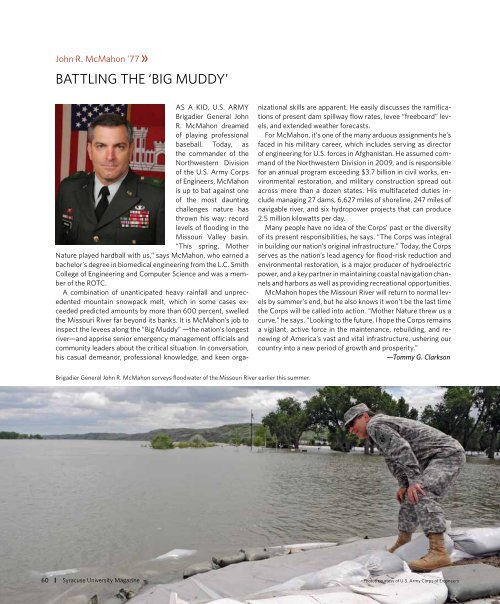Summer 2011.pdf - Syracuse University Magazine
Summer 2011.pdf - Syracuse University Magazine
Summer 2011.pdf - Syracuse University Magazine
Create successful ePaper yourself
Turn your PDF publications into a flip-book with our unique Google optimized e-Paper software.
John r. McMahon ’77 »<br />
BAttlinG the ‘BiG MUddy’<br />
AS A Kid, U.S. ArMy<br />
Brigadier General John<br />
r. McMahon dreamed<br />
of playing professional<br />
baseball. today, as<br />
the commander of the<br />
northwestern division<br />
of the U.S. Army corps<br />
of engineers, McMahon<br />
is up to bat against one<br />
of the most daunting<br />
challenges nature has<br />
thrown his way: record<br />
levels of flooding in the<br />
Missouri valley basin.<br />
“this spring, Mother<br />
nature played hardball with us,” says McMahon, who earned a<br />
bachelor’s degree in biomedical engineering from the l.c. Smith<br />
college of engineering and computer Science and was a member<br />
of the rotc.<br />
A combination of unanticipated heavy rainfall and unprecedented<br />
mountain snowpack melt, which in some cases exceeded<br />
predicted amounts by more than 600 percent, swelled<br />
the Missouri river far beyond its banks. it is McMahon’s job to<br />
inspect the levees along the “Big Muddy” —the nation’s longest<br />
river—and apprise senior emergency management officials and<br />
community leaders about the critical situation. in conversation,<br />
his casual demeanor, professional knowledge, and keen orga-<br />
Brigadier General John r. McMahon surveys floodwater of the Missouri river earlier this summer.<br />
60 <strong>Syracuse</strong> <strong>University</strong> <strong>Magazine</strong><br />
nizational skills are apparent. he easily discusses the ramifications<br />
of present dam spillway flow rates, levee “freeboard” levels,<br />
and extended weather forecasts.<br />
for McMahon, it’s one of the many arduous assignments he’s<br />
faced in his military career, which includes serving as director<br />
of engineering for U.S. forces in Afghanistan. he assumed command<br />
of the northwestern division in 2009, and is responsible<br />
for an annual program exceeding $3.7 billion in civil works, environmental<br />
restoration, and military construction spread out<br />
across more than a dozen states. his multifaceted duties include<br />
managing 27 dams, 6,627 miles of shoreline, 247 miles of<br />
navigable river, and six hydropower projects that can produce<br />
2.5 million kilowatts per day.<br />
Many people have no idea of the corps’ past or the diversity<br />
of its present responsibilities, he says. “the corps was integral<br />
in building our nation’s original infrastructure.” today, the corps<br />
serves as the nation’s lead agency for flood-risk reduction and<br />
environmental restoration, is a major producer of hydroelectric<br />
power, and a key partner in maintaining coastal navigation channels<br />
and harbors as well as providing recreational opportunities.<br />
McMahon hopes the Missouri river will return to normal levels<br />
by summer’s end, but he also knows it won’t be the last time<br />
the corps will be called into action. “Mother nature threw us a<br />
curve,” he says. “looking to the future, i hope the corps remains<br />
a vigilant, active force in the maintenance, rebuilding, and renewing<br />
of America’s vast and vital infrastructure, ushering our<br />
country into a new period of growth and prosperity.”<br />
—Tommy G. Clarkson<br />
Photos courtesy of U.S. Army corps of engineers




